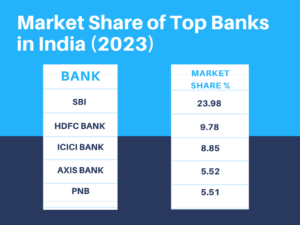Introduction:
For many years, Indians have preferred fixed deposits (FDs) as an investment option. They provide peace of mind and a safe and reliable way to build your savings. We’ll explore the justifications for thinking about investing in Indian bank FDs in this article. To help you make wise investment choices, we’ll also give you a thorough table of bank FDs that includes interest rates, risk considerations, regulations, and the market share of the top banks.
Why Consider Investing in Bank FDs in India?
1. Safety and Reliability:
Bank FDs are well-known for being secure. They are protected by the Reserve Bank of India (RBI) and covered by the Deposit Insurance and Credit Guarantee Corporation (DICGC) for up to Rs. 5 lakh per depositor. The risk of capital loss is effectively eliminated as a result.
Due to their low risk, fixed deposits are regarded as one of the safest investing options. They are perfect for people who want to earn income on their investments without being exposed to market volatility because they provide guaranteed returns.
2. Steady Returns:
Bank FDs are an appealing option for risk-averse investors because they offer reliable and assured returns. Because interest rates are fixed at the time of deposit, an income stream is guaranteed to be predictable. Banks and other financial institutions provide fixed deposit accounts as an investment vehicle. Investors would make a lump sum deposit into this account over time. They would get a predetermined rate of interest in return for the duration of the investment.
3. Wide Range of Options:
The FD alternatives offered by Indian banks are varied, with terms ranging from a few days to several years. With this freedom, you may match your investment to your financial objectives. There are numerous reputable banks in India that provide a wide selection of Fixed Deposit (FD) options with a number of features, including nomination capability, aggressive interest rates, joint accounts, loan/overdraft capabilities, and others. Let’s examine some of the greatest banks’ FD interest rates in more depth.
4. Liquidity:
Although FDs have lock-in periods, most banks offer the option of premature withdrawal, albeit with associated penalties. This feature provides a degree of liquidity, especially in unforeseen financial situations. Fixed Deposits are accessible investments that can be taken out whenever you need them. You can withdraw money in an emergency even before the FD matures. This would, however, be considered a premature withdrawal, which would result in penalty interest of 1% to 2% on your gains as of the date of the withdrawal.
5. Tax Benefits:
Tax incentives under Section 80C of the Income Tax Act are applicable for 5-year tax-saving FDs. However, it’s essential to be aware that interest income is subject to taxation. The current TDS (Tax Deducted at Source) rate for FD is 10%. if more than Rs. 40,000 in interest was earned on FDs throughout the fiscal year. However, TDS is withheld at a rate of 20% if the investor’s PAN is not readily available.
6. Regular Income:
FDs can be configured to provide a steady source of income by opting for periodic interest payouts. This characteristic makes them suitable for retirees and individuals seeking regular income. At maturity, the principal is repaid, and interest is paid on a monthly, quarterly, half-yearly, or annual basis. Select the non-cumulative fixed deposit for a monthly payout frequency if you want to get a monthly income from FDs. For information on monthly FD revenue, check the FD rates.
RBI Regulations and Security:
The Reserve Bank of India (RBI) plays a pivotal role in regulating bank FDs to ensure the security of depositors. Here are key RBI regulations and security aspects:
1. Interest Rate Regulations: RBI oversees the interest rates offered on FDs to prevent unfair practices. Banks are required to adhere to these guidelines when setting FD interest rates.
2. Maturity and Renewal: RBI mandates that banks specify the maturity date of FDs at the time of deposit. Banks must also inform depositors about the auto-renewal process and obtain consent for the same.
3. Nomination Facility: RBI ensures that banks offer a nomination facility, enabling depositors to nominate a beneficiary who will receive the FD proceeds in the event of the depositor’s demise.
4. Depositor Insurance: As previously mentioned, the DICGC, a subsidiary of RBI, provides deposit insurance to safeguard depositors’ funds, covering amounts up to Rs. 5 lakhs per depositor per bank.
Detailed Table of Bank FDs in India:
Here’s a table summarizing key information about some major bank FD’s offerings:
Market Share of Top Banks in India (2023):
Here’s a table displaying the market share of the leading banks in India as of 2023:
How Much Should You Invest?

The amount you should invest in bank FDs depends on your financial goals, risk tolerance, and existing investments. Generally, it’s advisable to have a diversified investment portfolio that includes a mix of assets like equities, debt, and FDs.
As a rule of thumb, you could consider allocating a portion of your portfolio to FDs, especially for short-term financial goals or to preserve capital.
Before considering long-term FD investments, ensure you have an emergency fund set aside in a liquid and easily accessible form.
Conclusion:
In India, purchasing bank FDs is a safe way to increase your savings and make money. They are best suited for people who are afraid of taking risks and want steady profits. To create long-term wealth, it is crucial to match your FD investments with your financial objectives and take other investment strategies into account. For specific, situation-specific investing advice, always speak with a financial advisor.
Why invest with iCreditSpace?
It is India’s Best Investment App that provides secured returns with less risk than stocks and with more returns than FDs. Due to its emphasis on fixed-income assets, diversification, expert management, low minimum investment, regulation, low volatility, and investing in government securities, iCreditSpace is regarded as a low-risk investment app in India. Due to these elements, iCreditSpace is an appealing investment choice for people seeking low-risk investments and helps to lower the chance of loss for investors. Additionally, it offers India’s top low-risk investing opportunities!

